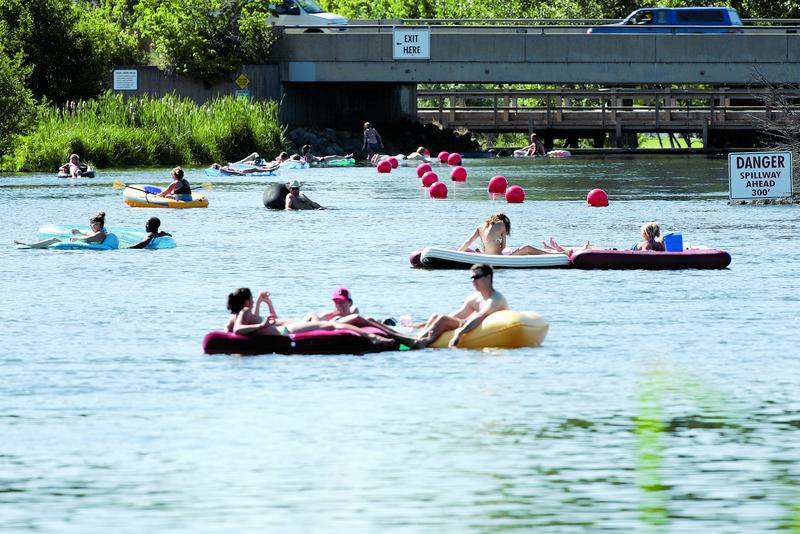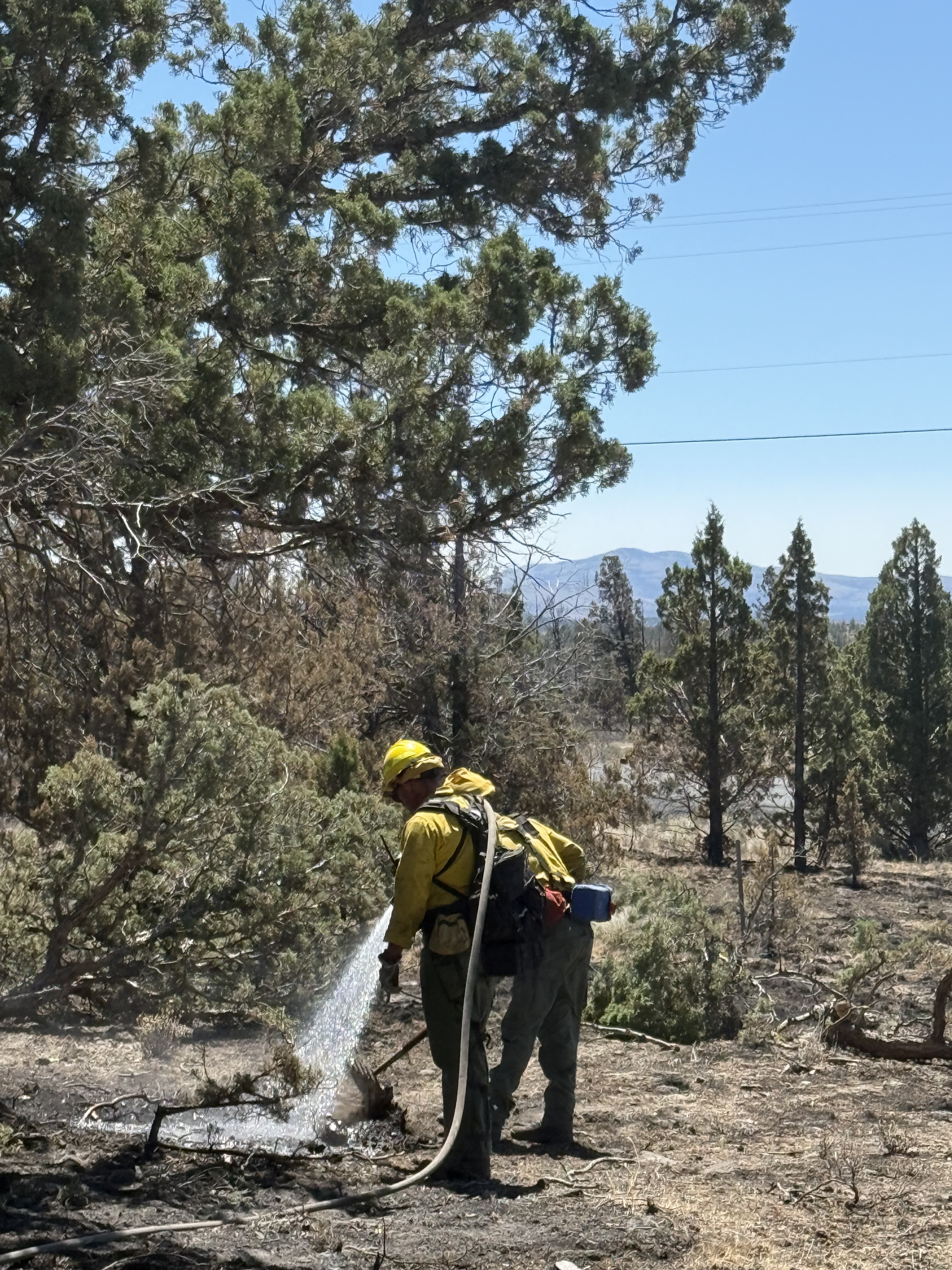Who is responsible for the river?
Published 5:00 am Sunday, August 6, 2006

- A line of buoys aids in directing rafters, boater and floaters to the designated point for getting out of the Deschutes River on the west bank upriver from the spillway. Lives have been lost at the spillway, visible in the background, beyond the Colorado Street Bridge in Bend.
Carrying an air mattress past the spillway under the Colorado Avenue Bridge, 17-year-old Brooke Bell, of Portland, said she could understand how some Deschutes River users underestimate the danger of the dam at the Colorado Avenue Bridge.
”I know the first time we floated, we were with a friend (who) said, ‘We (have) got to get out,’ and we said, ‘Why?’” she said. ”Visually, it doesn’t look that scary.”
Trending
But two drownings in as many summers and several close calls at the dam under the Colorado Avenue Bridge prompted several local residents to ask why the city and park and recreation district haven’t done more.
”Something definitely needs to be done,” Bend resident Erin Smith said. She saw the July drowning of 48-year-old Young-Sook Kuga, of Keizer.
”I know adults need to be held accountable, but if they’re opening the river … the city needs to be held accountable (too),” she said.
Part of the difficulty, officials said, lies in trying to protect people from their own carelessness. Because of state regulations intended to encourage recreation and conditions unique to Bend, nobody is ultimately in charge of floaters’ safety on the water, other than themselves.
The Bend Metro Park and Recreation District currently relies upon signs and a string of orange buoys meant to guide people to a portage path on the west bank of the river directly upstream of the Colo-rado Avenue Bridge.
Cristina Ortiz, who also witnessed the drowning, said those measures aren’t enough. She suggested creating exit points further upriver and danger signs in different languages.
Trending
”The buoys they have are worthless. We take walks and see people go through the buoys,” she said. ”Personally, I think there should be a net or something.”
Bend resident Tommy Ford, 17, disagreed.
”It’s not that hard to get out,” he said. ”There’s plenty of signs already. There’s too many buoys.”
District Executive Director Don Horton said the district has shouldered the responsibility for signs because it created access to the river at Farewell Bend Park as the park took shape two years ago.
The park and recreation district owns both sides of the river along Farewell Bend – a popular put-in point – and the west bank of the river just downstream of the dam, where McKay Park is located.
The owner of the banks also owns the riverbed to its midpoint, according to the Oregon Department of State Lands’ Web site.
The city owns no land on the banks, and the Bend City Council has not discussed creating a barrier to keep people from going over the dam, councilors said.
The river is generally no more than knee deep as it runs through Farewell Bend Park, where it is park district property. But it deepens to anywhere from 6 to 8 feet just upstream of the dam, where the buoys are located. The current becomes swift and strong as it nears the dam.
The dam itself and both sides of the riverbank, between Farewell Bend and McKay parks, belong to the River Bend Limited Partnership, developer of the Old Mill District. Bill Smith is the principal partner in the business group.
But that doesn’t make the partnership responsible, according to attorney Neil Bryant.
Bryant, legal counsel for the park and recreation district, said Oregon law protects private property owners who provide free access to their land for recreation.
”The Legislature and the government have said recreation is important, and if you allow people to recreate on your property at no cost, you shouldn’t be held responsible if they’re injured,” Bryant said. ”The first responsibility has to lie with the people who are rafting or inner tubing.”
Ownership
Although the River Bend Limited Partnership owns the dam, it was originally constructed in 1916 by the Brooks-Scanlon and Shevlin-Hixon timber companies. The dam raised the level of the water, allowing loggers to float logs to the sawmill, located near what are now The Shops at the Old Mill.
Today, the dam serves little practical purpose.
Smith, of the River Bend Limited Partnership, said the river around the dam was completely off-limits to the public until the mid-1950s.
But with the development of the Old Mill District in the late 1990s, the partnership sold a portion of its riverfront property to the park and recreation district to let people get on the river, he said.
”We want people to enjoy the river,” Smith said. ”It’s a wonderful amenity.”
Smith built the portage path in the 1990s to allow paddlers to take watercraft around the dam at the Colorado Avenue Bridge, Horton said.
With the increasing popularity of the river, though, the take-out point often becomes a ”traffic jam” of people using pool toys, inner tubes and air mattresses, Horton said. The path was designed for canoes and kayaks.
Michael Patrick Wilhite, a 20-year-old Bend Elks player who drowned in July 2005, fell into the water as he attempted to get off his raft near the portage path. His blood alcohol content at the time was more than twice the legal limit of .08 for drunken driving or operating a boat.
After the first drowning, the park and recreation district beefed up its signs and installed orange buoys, Horton said. This season, the district published several ads with a map of the river, including the spillway, beginning in May and created a flier for riders on the river shuttle.
But he said the people most at risk – visitors who are unfamiliar with the river’s dangers – are generally the hardest to reach.
In early July, the river claimed the life of Keizer resident Young-Sook Kuga. Her family could not be reached for comment.
In response to the drowning, the district upped the number of buoys in the river, to a total of 16, directly upstream of the dam.
Smith said he believes the district has taken all the necessary steps to try to protect river users.
”Can we protect everyone from themselves? I don’t think so. But we can make it more difficult for people to be dumb,” Smith said. ”We might be there. We might have done as much as we can without closing the river.”
He said River Bend has no intention of closing the river on their property. Even if the business tried to do so, it might not be successful. Oregon courts have ruled that the public can float and paddle on waterways for recreation even where the underlying bed is privately owned, according to the Web site of the Oregon Department of State Lands.
Breaching the dam
Smith said tearing out the dam is not a practical solution.
Irrigation and fire suppression systems for the Old Mill District rely on the current water level created by the dam to operate properly, Smith said.
Ryan Houston, executive director of the Upper Deschutes Watershed Council, said that the dam has also had an unexpected environmental benefit: creating a roughly 6-acre wetland near the Les Schwab Amphitheater. Removing the dam would likely cause the water level to drop several feet, he said, causing the wetland to dry out.
Houston said there are differing viewpoints about the dam’s impact on fish passage and how effective an aluminum fish ladder, installed in 1998, has been.
He said the Upper Deschutes Watershed Council hasn’t lobbied to remove the dam.
Smith said people have talked about breaching the dam several times over the past 30 years, but each time, reasons to keep the dam have prevailed.
”There are pluses and minuses and uncertainties on both sides,” he said. ”The dam (has) been there a long time, and every time people have talked about it, the benefits of leaving it in have outweighed the benefits of taking it out.”
At present, Smith and the park and recreation district are working together to hire an engineer to take a fresh look at the hazards of the dam and think of solutions.
One idea that whitewater paddlers have proposed in the past is some sort of chute under the dam that allows kayaks and canoes through.
Bend Paddle Trail Alliance President Karl Koenig said chutes have been created on other dammed rivers to create a safe passage for paddlers. The alliance is not formally backing any particular solution, he said, but the drownings point to a need for one.
Koenig said a chute may not work given the large number of floaters, who might capsize or get thrown off trying to go through.
”It’s hard to make something 100 percent safe,” he said. ”(We) just ask the question, ‘What’s possible?’”
Little regulation
Forcing floaters to play it safe is difficult because single inner tubes, pool toys and air mattresses don’t fit the state definition of a watercraft, according to Bill Rydblom, administrator of the law enforcement program at the Oregon Marine Board.
”Since we’re Oregon’s boating agency, if it’s not a boat, we can’t touch it,” he said. ”We would like everyone to be safe, but we can only regulate boating activity.”
At the river on a recent afternoon, Redmond resident Misti Bumbalough, 29, said nobody in her family is allowed in the river without a life vest. Bumbalough and her three children were all wearing life jackets.
”It should be like a car seat for a kid,” she said. ”Adults, they can risk their life. Kids, they’re going to do what their mom and dad tell (them) to.”
Rydblom said the marine board does try to educate river users to help keep them safe, but there is no state law that prohibits floaters from trying to run rapids on an air mattress.
He said 85 percent of the people who die in boating accidents would have lived if they had worn a life jacket. Rydblom said he believed the same would be true of people using floating devices, which are more prone to flipping or throwing their riders in rough water.
”Always wear a life jacket and leave the alcohol at home,” he said. ”If you want to drink on a hot day, there (are) a lot safer places to do it than on the water.”
The message about alcohol, at least, seems to be getting through.
In June, the Bend City Council passed an ordinance that prohibits people from possessing or consuming alcohol while they are in or on the Deschutes River.
And while no regulation specifically prohibits alcohol on the river banks, it is illegal to drink or possess an open container of alcohol in a city park without a permit.
Capt. Sandi Baxter of the Bend Police Department said she has seen a dramatic drop in the number of people drinking on the river compared to last summer. She could not provide specific numbers.
Although the police department maintains a bike patrol of the river, she credited education by the police department and the park and recreation district with cutting the amount of booze on the river.
Aside from rules about alcohol, officials said the lack of regulation makes it imperative river users look out for themselves and each other.
Horton at the park and recreation district said that the community can and should shoulder the responsibility for safety on the river.
”We could stick our head in the sand and say, ‘Oh, this is a wild river and people need to use better judgment.’ Or we can come together as a community and say we need to address it,” he said. ”We want to come together and build partnerships … to reach solutions.”








